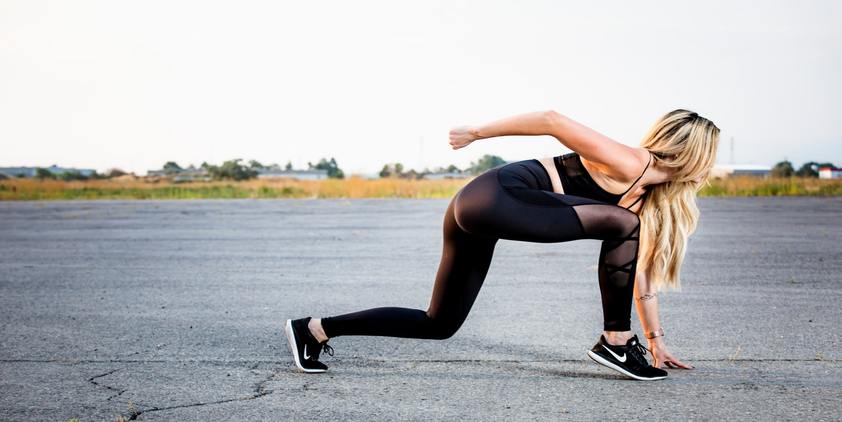

December 29, 2018 | Categories: Health
The subject of fat often pops up in everyday conversation. Whether people are gaining or losing it, it is a hot topic. But the understanding of fat isn’t as black and white as you may think. There are many things about body fat (like the fact that it’s good for your body) that you may not know about but should be aware of in order to live your healthiest life. Fitness expert and co-founder of the Transform App Chris Powell along with family physician and Associate Professor at Rowan University School of Osteopathic Medicine Dr. Jennifer Caudle help bust myths and explain the things you need to know when it comes to your fat. Check out these 7 surprising weight gain culprits.
There are two different types of fat in your body–white fat and brown fat. White fat, technically known as adipose tissue, is the more common type of fat. This fat is what our body collects from calories and stores until we need it. Chris Powell says that “When we consume more calories than our body burns, we brilliantly store the excess calories as this amazing ‘blanket of energy’ that covers our body. When we don’t consume enough energy for our needs, our body mobilizes the energy from the blanket and uses it. The average human can store between 90,000 to 140,000 calories of white fat blanketing their body – which is a lot of energy. In fact, that’s enough for nearly 150 hours of running.” White fat also plays a role in telling your body that you are full in addition to resisting insulin. While research is still being conducted on brown fat, there is a lot less of it in your body–a person may have 20 to 40 pounds or more of white fat but only two to four ounces of brown fat. Preliminary observation has shown that this brown fat is very active and burns calories similar to the way muscle building does.
White fat is divided into three main categories. First is visceral fat that wraps around the organs in your body which is very unhealthy and dangerous. Second is subcutaneous fat which is the most common type of white fat and is the layer of fat that is found between your muscle and your skin. Last is abdominal belly fat that is a mix of visceral and subcutaneous fat. Powell says research has shown that abdominal fat is correlated with an increased risk of diabetes, heart disease, stroke, and dementia, among other things. He warns that the average woman with a waist larger than 35 inches and an average man with a waist larger than 40 inches should be aware that they are at an increased risk of disease.
Most people hear the word fat and think of it as a negative thing, but fat is a beneficial and necessary part of your body. Powell says that fat does, in fact, have two main functions in the body that are needed for survival. Fat stores excess calories safely so you can use them for energy when you’re hungry. Additionally, your fat releases helpful hormones that help control your body’s metabolism. Just because fat is beneficial though, does not mean that you should store it in excess. Too much fat on the body, as mentioned before, can cause a lot of health problems.
The fat that collects right under your skin is called cellulite. It usually appears as dimples or lumpy skin most commonly on your butt, belly, and thighs. According to Dr. Caudle, how much cellulite you have can depend on many different factors. While what you weigh and the amount of fat you have on your body are definite factors, some factors that you can’t control like genetics, age, the thickness of your skin, and your gender could all impact the cellulite on your body. “People of all weights and sizes can have cellulite,” says Dr. Caudle, “even thin people can have it.”
While it may seem logical that losing weight means losing cellulite, that is not the case. If you are overweight, the appearance of cellulite may be more obvious because the more fat that’s under your skin the more apparent it will be. While losing weight doesn’t eliminate cellulite, Dr. Caudle says it might improve the appearance of it.
Powell says that “it is impossible to ‘spot reduce’ fat in just one region of the body.” What this means is doing a ton of crunches will not work by itself to get rid of belly fat. “Fat is actually lost globally across the entire body,” says Powell, so it is important to pick exercises that will burn the most calories all over your body for the best results. Powell suggests things like walking, jogging, running, cycling, rowing, boxing, and hiking in addition to strength training. You should also make sure to eat a well-balanced diet. In fact, Powell says that the most controlled way to get rid of fat is through nutrition. A combination of proper nutrition and weekly exercise is the best way to get rid of fat because eating healthy things and then burning calories through physical activity will help to burn off and reduce fat.
While diet is the first defense in losing body fat, everyone is different. This means there is not one cure-all diet that will magically help you lose weight. Powell says that as long as you stay in a calorie deficit – eat fewer calories than you burn – you will lose fat. However, Powell advises customizing your diet in order to lose fat faster. This means that you have to find what works for your body – vegan, paleo, ketogenic, Mediterranean, etc. You can simply experiment to see what works best, or you could talk to your doctor about a dietary weight loss plan that would be best for your body.
Read the full article on Doctor Oz.
Leave a Reply